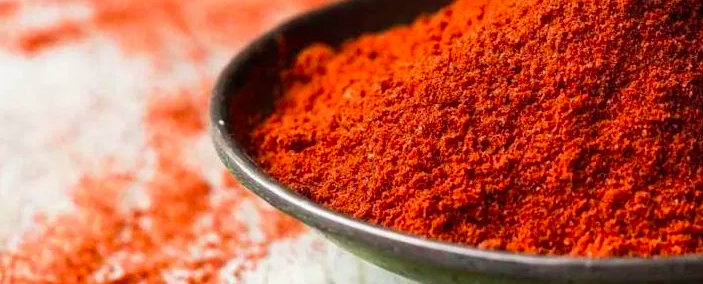
Paprika, a colourful spice rich in benefits
Paprika is a sweet pepper powder used as a condiment. It has been used for hundreds of years in Hungarian and Spanish cuisine, you no doubt know its taste but do you know the many health benefits behind this colorful spice?
Characteristics of paprika:
- Rich in iron;
- Source of potassium;
- Source of vitamin E;
- Source of vitamin K;
- Source of vitamin B2.
Paprika, what is it?
Paprika identity card
- Type: Pepper;
- Red color ;
- Flavor: Pungent and slightly pungent;
- Season: All year round.
Characteristics of paprika
At harvest, a red pepper is obtained which will then be dried and finely ground to obtain a spice.
Differences from related foods
Be careful not to confuse paprika with pepper, the pepper for its part has a very interesting vitamin C content that is not found in paprika consumed as a spice.
Word from the nutritionist
To take advantage of its benefits and preserve its particular taste, add paprika at the end of cooking your dishes.
Nutritional values of paprika
For 100 g of paprika:
| Nutrient | Amount |
| Water | 11.2 g |
| Carbohydrates | 19.1 g |
| Lipids | 12.9 g |
| Protein | 14.1 g |
| Iron | 21.1 mg |
| Magnesium | 178 mg |
| Potassium | 2280 mg |
| Zinc | 4.33 mg |
| Vitamin E | 29.1 mg |
| Vitamin C | 0.9 mg |
| Vitamin K | 80.3 µg |
| Vitamin B2 | 1.23 mg |
| Vitamin B3 | 10.1 mg |
| Vitamin B5 | 2.51 mg |
| Energy | 319 kcal |
| Energy | 1320 kJ |
8 benefits of paprika: why eat it?
- It is the capsaicin contained in paprika that will allow your body to fight effectively against small winter ailments.
- Recent studies have shown that regular consumption of paprika can help reduce joint pain, particularly related to arthritis.
- Consumed regularly, paprika will promote good blood circulation, to be incorporated into your recipes so if you are prone to heavy legs for example.
- It is thanks to its good vitamin B6 content that your hair will shine if you consume paprika regularly. Indeed, it will help reduce the loss of your hair.
- The iron present in paprika will allow oxygen to be transported through the body, if it is combined with other dietary sources of iron (legumes, meat, etc.) it will allow you to avoid anemia.
- A good potassium intake will allow you to optimize the contraction of the muscles and the heart. It also plays a role in nerve impulses.
- Paprika gets its antioxidant power from vitamin E which it contains in considerable quantity, so it will be very good for preventing cardiovascular diseases in particular.
- The vitamin B2 intake of paprika is considerable, this vitamin will notably participate in the maintenance of the mucous membranes of your body and your muscles.
Choosing the right paprika
Its coloring should be bright red and it should be reduced to powder form. There are several intensities of paprika: sweet, spicy or sweet and sour.
The different varieties
In Spain, paprika is called “pimenton”. Pimenton de la Vera, which has the Spanish equivalent of an AOC, is a very mild pepper (3 on the Scoville scale) smoked with oak wood, which gives it a slight taste of chorizo.
Keep well
Like all spices, paprika can be stored away from light, heat and humidity in an airtight jar.
Preparation of paprika
How to cook it? How to match it?
Paprika is used in traditional Hungarian or Spanish cuisine. It is found in particular in goulash recipes or in Spanish cold meats such as chorizo or soubressade. It will go very well with chicken, fish, tomatoes, onions or cream sauces.
For the summer, you can make a delicious marinade for white meats with paprika, onions and olive oil. After a night in this marinade, all you have to do is grill your pieces of meat on the barbecue.
To keep its sweet taste, consider incorporating it at the end of cooking and do not let it cook over a too high heat which would develop its pungent flavors.
Paprika is also often used for the decoration of dishes thanks to its beautiful red color which enhances the visual of a plate.
History of paprika
Originally from South America, paprika was brought to Europe by Spanish settlers. Little by little, he crossed Europe to land in Hungarian cuisine where he became a star spice.